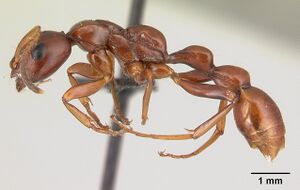Tetraponera merita
| Tetraponera merita | |
|---|---|

| |
| Scientific classification | |
| Kingdom: | Animalia |
| Phylum: | Arthropoda |
| Class: | Insecta |
| Order: | Hymenoptera |
| Family: | Formicidae |
| Subfamily: | Pseudomyrmecinae |
| Genus: | Tetraponera |
| Species group: | grandidieri |
| Species: | T. merita |
| Binomial name | |
| Tetraponera merita Ward, 2009 | |
Nests have been found on the ground in rotten logs, sticks and tree stumps. A worker from the type series (PSW10943) stung me on my left index finger. The sting was rather painful and left a pustule that lasted more than a week. It reinforced my impression that the conspicuous orange and reddish-brown coloration of workers of Tetraponera merita and related species in the T. grandidieri group is aposematic. (Ward 2009)
Identification
Ward (2009) - This is one of the more distinctive species in the Tetraponera grandidieri group, easily recognized by the presence of a tooth on the basal margin of the mandible and by the undercut median portion of the clypeus. T. merita is usually more or less unicolorous reddish- or orange-brown, without a contrastingly darker head, but in some northern populations (3.9 km S Ambaliha, Foret Antsahabe and Foret Binara) the head is infuscated relative to the rest of the body. This species also tends to be larger than all the others except Tetraponera manangotra (see HW, HL and LHT measurements).
Keys including this Species
- Key to Afrotropical Tetraponera
- Key to Afrotropical Tetraponera species
- Key to Tetraponera grandidieri species group
Distribution
T. merita is widely distributed in rainforest of eastern and northern Madagascar, overlapping the ranges of all other species in the T. grandidieri group. (Ward 2009)
Latitudinal Distribution Pattern
Latitudinal Range: -18.93333333° to -18.93333333°.
| North Temperate |
North Subtropical |
Tropical | South Subtropical |
South Temperate |
- Source: AntMaps
Distribution based on Regional Taxon Lists
Malagasy Region: Madagascar (type locality).
Distribution based on AntMaps
Distribution based on AntWeb specimens
Check data from AntWeb
Countries Occupied
| Number of countries occupied by this species based on AntWiki Regional Taxon Lists. In general, fewer countries occupied indicates a narrower range, while more countries indicates a more widespread species. |

|
Estimated Abundance
| Relative abundance based on number of AntMaps records per species (this species within the purple bar). Fewer records (to the left) indicates a less abundant/encountered species while more records (to the right) indicates more abundant/encountered species. |

|
Biology
Castes
Worker
Images from AntWeb
   
| |
| Holotype of Tetraponera manangotra. Worker. Specimen code casent0120025. Photographer Erin Prado, uploaded by California Academy of Sciences. | Owned by CAS, San Francisco, CA, USA. |
Male
Images from AntWeb
   
| |
| Male (alate). Specimen code casent0135786. Photographer Dimby Raharinjanahary, uploaded by California Academy of Sciences. | Owned by CAS, San Francisco, CA, USA. |
Nomenclature
The following information is derived from Barry Bolton's Online Catalogue of the Ants of the World.
- merita. Tetraponera merita Ward, 2009: 300, figs. 1, 17, 18, 26 (w.q.m.) MADAGASCAR.
Unless otherwise noted the text for the remainder of this section is reported from the publication that includes the original description.
Description
Worker
(n = 9). HW 1.16-1.59, HL 1.23-1.74, LHT 1.38-1.83, CI 0.90-0.94, FCI 0.11-0.15, REL 0.31-0.34, REL2 0.34-0.38, SI 0.76-0.82, FI 0.28-0.32, PLI 0.49-0.56, PWI 0.46-0.53.
Similar to Tetraponera grandidieri (q.v.). Basal margin of mandible with conspicuous tooth; anterior clypeal margin deflected ventrally; head relatively broad (CI 0.90-0.94); metanotal spiracle visible in lateral view of mesosoma; dorsal face of propodeum broadly convex in posterior view; standing pilosity and appressed pubescence generally sparse; integument mostly sublucid, with fine coriarious/puncticulate sculpture; orange to reddish-brown, appendages paler; head usually concolorous with mesosoma.
Type Material
Holotype worker. MADAGASCAR Toamasina: 1 km SSW Andasibe ( = Perinet), 920 m, 18°56'S 48°25'E, 16.xi.1990, ex rotting tree stump, rainforest, P. S. Ward #10943 (CASENT0012863) (California Academy of Sciences). Paratypes. Series of workers and queens, same locality as holotype, 16.xi.1990 and 12.xii.1990 (P. S. Ward#l0939, 19043, 10944-3, 11144) (The Natural History Museum, CASC, Museum of Comparative Zoology, Philip S. Ward Collection, South African Museum, University of California, Davis).
Identification Clarifications
Although the holotype of T. grandidieri hildebrandti is conspecific with T. grandidieri, material referred to T. g. hildebrandti by Forel (1892: 260) includes T. merita. During earlier examination and identification of museum material I assigned the code name Tetraponera psw92 to this species.
References
- Ward, P.S. 2009. The ant genus Tetraponera in the Afrotropical region: the T. grandidieri group. Journal of Hymenoptera Research. 18:285-304.
- Ward, P. S. 2022. The ant genus Tetraponera (Hymenoptera: Formicidae) in the Afrotropical region: taxonomic review and key to species. Zootaxa 5102 (1):1-70 (doi:10.11646/zootaxa.5102.1.1).
References based on Global Ant Biodiversity Informatics
- Ward P. S. 2009. The Ant Genus Tetraponera in the Afrotropical region: the T. grandidieri group (Hymenoptera: Formicidae). Journal of Hymenoptera Research: Festschrift Honoring Roy Snelling, 18: 385-304

